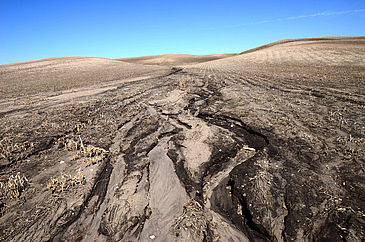Soil forms the basis of almost all biological processes on the continents. For millions of years, weathering and erosion were controlled mainly by climatic influences. In the recent past and at local and regional level, anthropogenic activities have become the main cause of soil erosion. It remains unclear, however, whether human-induced soil erosion has any global impact.
To answer this question, a team of international scientists led by French geoscientist Jean-Philippe Jenny from the Max Planck Institute for Biogeochemistry in Jena and the CARRTEL Limnology Center in Thononon-les-Bains, France, looked back into the past. They examined drill cores of sediments from 632 lakes worldwide, which have been recorded by scientists over the past decades. “Sediments in lakes are considered natural archives for soil erosion processes. All the solid and dissolved substances discharged from the drainage basins of the lakes are chronologically preserved at the bottom of the lakes,” says Dr. Jenny.
With the help of radiocarbon dating and seasonally stratified sediments, comparable to tree ring chronologies, the scientists precisely determined the age of the sediment layers and their sedimentation rates. “More than one-third of all the investigated lakes provided evidence of an increased sedimentation rate as early as 4,000 years ago,” says Bernd Zolitschka, coauthor of the study and professor at the Institute of Geography at the University of Bremen.
In their search for possible causes, the researchers also examined sediment pollen data in order to reconstruct changes in vegetation cover in the drainage basins of the lakes. They were able to draw on existing data bases. “We were surprised to see that the increase in sedimentation rates 4,000 years ago coincided with a reduced amount of tree pollen,” says Dr. Jenny. “The decline in tree pollen is due to deforestation, in particular deforestation linked to agriculture and new settlements. This in turn promoted soil degradation and erosion,” confirms Professor Zolitschka. Further statistical analyses support the assumption that it was mainly the change in vegetation cover that led to accelerated soil erosion in the drainage basins of the lakes.
On closer examination of their newly combined data, the researchers discovered further interesting relationships: At the regional level, changes in sedimentation rates seem to correlate with socioeconomic developments in the course of settlement history. Thus, the increase in soil erosion in North America began much later than in Europe. This probably corresponds to a delayed introduction of European agricultural practices in North America that only came with colonization. Conversely, the decline in soil erosion in 23 percent of sites is probably associated with improved water management, especially in the Roman and Chinese empires about 3,000 years ago.
In summary, this study suggests that changes in the tree population in the drainage basins of rivers and lakes have long been the main factor for soil erosion. In addition, anthropogenic deforestation explains the accelerated soil erosion over the last four millennia. “Already at the beginning of the early agricultural activities in the neolithic, humans changed their natural habitats and adapted them to their needs. This was often accompanied by a destabilization of environmental conditions, such as increased soil erosion 4,000 years ago. A process that has not yet been stopped worldwide and which will accelerate further as a result of rising greenhouse gas emissions and the associated climate change,” says Bernd Zolitschka, who contributed data from the well-dated and interdisciplinary Holzmaar sediment archive, a crater lake in the Western Eifel, to this study.
Additional Information:
Press release Max Planck Institute for Biogeochemistry, Jena: https://www.bgc-jena.mpg.de/www/index.php/PublicRelations/NewsSingle?userlang=enahr=2019d=1572259324isc
Contact:
Professor Bernd Zolitschka
Institute of Geography
University of Bremen
Tel.: +49 421 218-67150
E-mail: zoliprotect me ?!uni-bremenprotect me ?!.de

